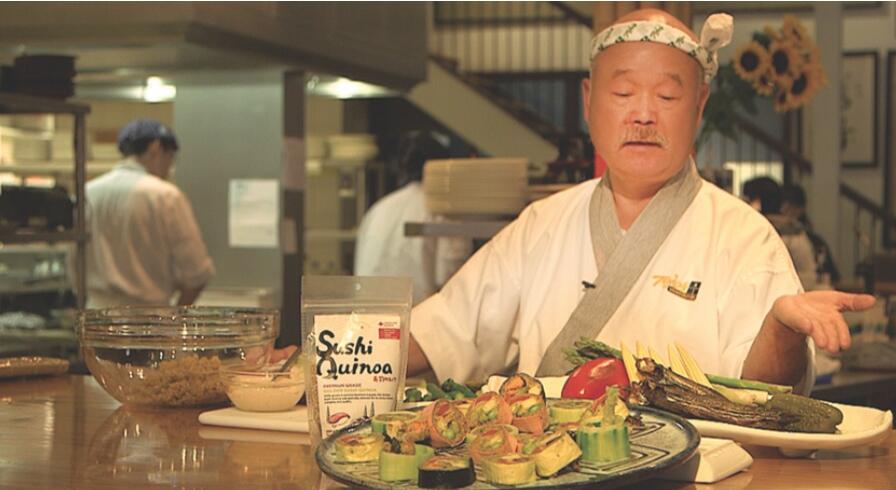Canadian-grown grain could tap new Asian trade market as a substitute for rice
By Chuck Chiang | June 8, 2017, 1 p.m.

Chef HidekazuTojo prepares a roll of quinoa sushi at his Vancouver restaurant, Tojo’s | Photo: Albert Van Santvoort
It might be only one restaurant – albeit a renowned one owned by a legendary Vancouver sushi chef – but what’s being launched there could unlock the lucrative but hyper-protectionist East Asian rice market to Canadian producers.
The key ingredient, however, might not be rice at all. Rather, it is quinoa, the healthy grain increasingly found in many West Coast recipes. And, starting now, it can be found in the sushi offerings of chefHidekazuTojo at his Vancouver establishment, Tojo’s.
“I know lots of regular customers who come here, and in the last three weeks, we’ve being serving this to them,” said Tojo, who started in Vancouver’s restaurant scene in 1974, pioneered a number of dishes (like the California roll) and is now one of only a handful of chefs based outside of Japan to be named goodwill ambassador for Japanese cuisine by Tokyo.
“These are customers for 35, 40 years, and some told me, ‘Tojo, we are looking for this one’” – he points to a plate of quinoa sushi – “when they returned. So the reaction is very strong. I’m very confident.”
That reaction is what the Vancouver company supplying the quinoa to Tojo is hoping for when it takes the grain into Japan. Blair Bullus, president of Top Tier Foods Inc., said efforts are already underway to introduce quinoa as a sushi base in the Land of the Rising Sun.
“Understanding those opportunities in Japan does require a little extra time and a little extra patience,” Bullus said. “So our lead time for moving in, as opposed to being a few months out, will be about six months to a year. … But when we partner with a company like Tojo’s, it will accelerate that process a little bit, and we are now starting to get some feedback that, yes, this is a product people are looking for.”
The key in this equation, Bullus said, is Canadian quinoa grown in Saskatchewan, which is thicker and stickier than traditional Peruvian or Bolivian quinoa. While that doesn’t work well with traditional quinoa dishes, Bullus noted that when he took the product to researchers at the British Columbia Institute of Technology, they found the material closely matched the texture of Asian short-grain white rice.
After a product development phase involving Victoria’s Wise Coast Foods Ltd., Bullus participated in a provincial trade mission to Japan, South Korea and China to test the waters for the grain as a rice replacement.
“For us, we got unbelievable feedback from that,” he said. “The texture of sushi rice is a familiar one to the Asian market. The stickiness is familiar; when you eat with chopsticks, you are able to pick it up, unlike traditional quinoa.”
At the same time, Top Tier began engaging chefs and restaurant owners in North America to raise the visibility of quinoa as sushi rice. That’s when Tojo took notice.
“Me, I ate quinoa with salad, but it’s not sticky,” Tojo said. “Blair’s recommendation is what I was looking for. People are very concerned about health, so I recommend quinoa-rice sushi. … Even in Japan, it’s becoming popular. I saw [a program] on [Japanese national broadcaster] NHK three weeks ago that was talking about quinoa. But not sushi, just with salad. So this is the first time it’s being used with sushi.”
Rice is one of the most protected commodities in East Asian markets. When Japan and South Korea discuss free trade with North America, rice farmers and their lobbies have always formed a main pillar of opposition.
In some cases, the reason is food security; East Asian countries are loath to hurt domestic suppliers who would be the go-to suppliers should a food shortage arise. That’s the case with China, where Bullus has not found an opening, and South Korea, where tariffs for any grain that competes with rice can reach 800%.
“Although we have a free trade agreement [between Canada and South Korea] where that tariff is coming down, it’s coming down incrementally, so it would not be eliminated until about six years from now,” Bullus said, although he added he is trying to engage Korean officials on getting another channel open.
Meanwhile, Bullus’ Asia focus is on Japan, where Top Tier is looking for experienced Japanese market exporters to untangle the numerous regulations. But he added that Tojo’s reputation internationally may be crucial in tapping that potentially lucrative market in the world’s third-largest economy where rice is the most-consumed food commodity.
“When you have a reputation like Tojo’s – innovative, being able to make new products work in new markets – it’s something we’ll leverage to the best of our ability,” Bullus said. “The market is the ultimate reward.”


















